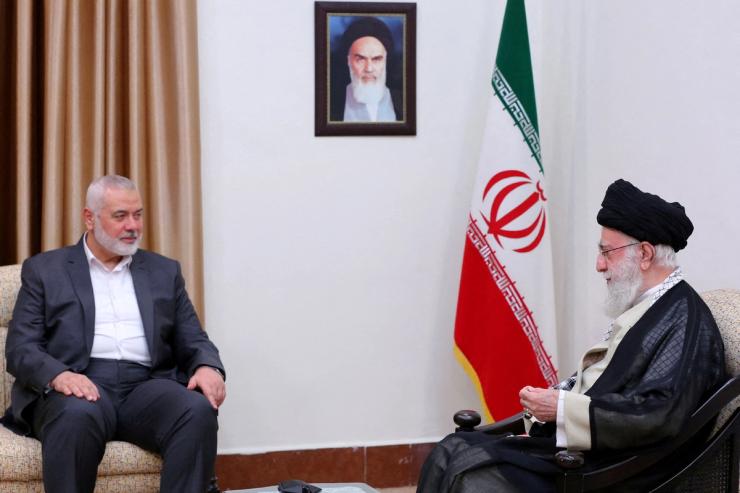The News
Iranian-backed militias have launched more than 45 attacks on U.S. bases in the Middle East in the last five weeks since the Palestinian militant group Hamas carried out a deadly terror assault on Israel — prompting the Pentagon and White House to question whether their strategy for deterring Tehran is working.
The strikes on U.S. troops in Iraq and Syria, in support of the Iran-backed, trained and funded Hamas, came despite the deployment of U.S. carrier strike groups to the Mediterranean and Red Seas and three reprisal strikes against what the Pentagon says are operational facilities controlled by Iran’s elite military unit, the Islamic Revolutionary Guard Corps (IRGC), in Syria. On Sunday, the U.S. hit an IRGC-controlled weapons depot and command-and-control center in eastern Syria, killing at least eight fighters, according to an outside war monitor.
“These attacks must stop, and if they don’t stop, then we won’t hesitate to do what’s necessary, again, to protect the troops,” Secretary of Defense Lloyd Austin said Monday in South Korea, suggesting the Pentagon could take more military action against Iran and its proxies.
A number of current and former U.S. officials told Semafor that they’re worried that the Pentagon’s calibrated responses to the attacks are weakening the U.S.‘s redlines and deterrence in the Mideast and only encouraging Tehran and its proxies to take more risks. Iran’s allied Houthi army in Yemen has fired a string of long range missiles and attack drones at Israel since October 7. And Lebanon’s Hezbollah militia, perhaps Tehran’s most powerful military proxy, is engaging in regular border skirmishes with the Israel Defense Forces.
These U.S. officials argued that the Pentagon — while stopping short of attacking Iran directly — should much more aggressively seek to neutralize the IRGC’s military infrastructure in Iraq, Syria and Yemen, while also conducting cyber operations to disrupt Tehran’s military operations outside Iran.
“If we have this concept of military deterrence, the one thing about the concept is that it’s a self-grading homework assignment,” said Mick Mulroy, who served as deputy assistant secretary of defense for the Middle East during the Trump administration. “If they [Iran] keep striking us, and they keep intensifying the strikes, then deterrence just isn’t working. There’s no other way to put it.”
The Trump administration assassinated Iran’s and the IRGC’s most powerful military commander, Brigadier General Qassem Soleimani, in a 2020 drone strike in Iraq, which Iranian officials have vowed to avenge.
But senior Biden administration and Israeli officials reject the idea that Tehran isn’t constrained. They said their priority right now is to allow the Israel Defense Force (IDF) to focus on its military campaign against Hamas — which is aimed at essentially uprooting the organization from Gaza — without allowing Iran and its other proxies to enter the battle in a major way.
They said the proxy attacks, while troubling, aren’t impacting Israel’s overall mission. And they point to two major speeches given this month by Hezbollah’s leader, Hassan Nasrallah, in which he signaled that he wasn’t going to escalate in any major way, as a sign Tehran is limiting its allies’ operations.
“I think, yes, we are confronting the proxies of the Iranians, but the Iranians are using them in a very, very cautious way,” said Yaakov Amidror, a former national security advisor to Israeli Prime Minister Benjamin Netanyahu. “I think it is wrong to say that the Iranians are not deterred by the combination of Israel and the Americans.”
In this article:
Jay’s view
Iran’s Islamist rulers have built up over the past four decades a network of allies and proxies, called the Axis of Resistance, as a tool to curtail U.S. military power in the Mideast. Tehran has also used these allies, and, in particular, Hezbollah and Hamas, to essentially encircle Israel and dissuade the Jewish state from launching strikes on Iran’s nuclear infrastructure. The Axis has also sought to check Israel’s growing partnerships with leading Arab states, brokered by the U.S. through the the Abraham Accords, which could grow to include the regional heavyweight, Saudi Arabia.
Israel’s current war with Hamas will likely determine whether Iran’s Axis is empowered or significantly weakened.
Iran’s revolutionary government has committed since its inception in 1979 to eliminate Israel. And the ongoing conflict in the Gaza Strip appears to provide Tehran the opportunity to significantly weaken the country both strategically and psychologically. Hamas’s October 7 attack on southern Israel was the most successful by a Palestinian militant group in history and resulted in the largest single-day loss of Jewish life since the Holocaust. If Tehran rallied its proxies and allies — including Hezbollah, the Houthis and the Syrian and Iraqi militias — to attack Israel simultaneously, the IDF would be seriously tested.
“The continuation of war crimes against Palestine and Gaza will receive a response from the rest of the Axis,” Iran’s Foreign inister Hossein Amir-Abdollahian said last month. “And naturally, the Zionist entity and its supporters will be responsible for the consequences of that.”
But Supreme Leader Ayatollah Ali Khamenei’s refusal so far to unleash Hezbollah on Israel’s northern front, and the still limited military roles played by Tehran’s other proxies, suggests Iran’s ruler and the IRGC don’t want to risk losing these strategic assets in a wider conflict with Israel and the U.S. today. Hezbollah is estimated to have 150,000 missiles and rockets trained on Israel’s key military and economic centers, most of which could be lost. “They are not ready to sacrifice Hezbollah’s capabilities,” Amidror said of Iran’s leadership.
Nasrallah, in his two recent speeches, suggested he still saw Hezbollah’s conflict with Israel playing out for decades, rather than concluding in some major conflagration this year. “What’s taking place on our front is very important and significant,” Nasrallah said on November 3. “Yet I assure you this will not be the end. This will not be sufficient.”
The View From Iran
Khamenei and other Iranian officials have praised Hamas’s October 7 attack, but also sought to distance Tehran from the Gaza war. Tehran and Hezbollah have both publicly claimed that they played no operational role in planning the operation and that it was solely conceived and executed by Hamas. “It was a 100% Palestinian operation, planned and executed by Palestinians for the Palestinian cause,” Nasrallah said. “It has no relation at all to any international or regional issues.”
Khamenei met with Hamas’s overall political leader, Ismail Haniyeh, earlier this month in Tehran. And Reuters reported Wednesday that Iran’s supreme leader stressed to the Palestinian official that Tehran and the IRGC won’t directly engage in the Gaza war, unless the U.S. attacks Iran directly.
Notable
- The U.S. Treasury placed fresh sanctions on Hamas Tuesday, seeking to cut off money transfers from Iran.
- Hamas and Hezbollah have had a challenging relationship, supporting opposite sides in the Syrian civil war.


